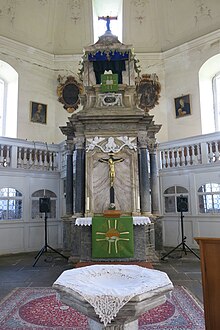Döschnitz village church
The Protestant village church Döschnitz is located in the municipality of Döschnitz in the Saalfeld-Rudolstadt district in Thuringia .
history
The construction of the church in the late baroque style dates back to 1732, as the previous church was no longer usable and had to be demolished. However, it took 38 years until the final completion and inauguration of the church on July 24, 1770. Pulpit altar , baptismal font , galleries and the ceiling decorated with filigree stucco elements are foundations of wealthy families.
The initiator of the building of the church was the pastor Magister Christian Friedrich Scharff (born October 2, 1693 in Auleben; † September 12, 1751 in Allendorf). Scharff, who worked in Döschnitz from 1721, moved to Allendorf in 1734 and handed over the pastoral position in Döschnitz to Johann Wolfgang Wintzer (1734–1751). This was followed by pastors Adolph Anton Haucke (1751–1763) and Johann Christoph Lunderstedt (1764–1780). The latter saw the completion of the church and its consecration in 1770. His successor was Johann Gottlob Scherr (1780–1800).
Furnishing
For the construction of the church, marble was used , which was quarried in a quarry above the church and the cemetery. A special attraction is the pulpit altar, which consists of light and dark, gray-yellow and red speckled Döschnitzer marble. On the back of the altar there are two relief panels from the old church. They represent the crucifixion of Christ and the resurrection. Underneath there is a sacramental niche closed with an iron lattice door . The relief plates are fragments of an epitaph for Sebastian Leonhard von Schaumburg, church patron until his death in 1593. This wall tomb is attributed to Nicolaus Bergner, a Thuringian sculptor of the late Renaissance. It was probably smashed when the old church was demolished in 1732.
Johann Michael Wagner from Schmiedefeld am Rennsteig took over the construction of the organ in 1751. He had just started his own business as an organ builder and founded a family business with his brother Johannes. The project in Döschnitz was his first order to build a new organ. In 1969 all visible pipes were made anew. The old pipes had to be handed in for war purposes in 1939.
The baptismal font, also made of marble, was donated by Johann Martin Bergmann in 1737. Left and right behind the pulpit hang two memorial plaques decorated with artistic wood carvings. You are Pastor Wintzer and his son Dr. phil. and med. Dedicated to Johann Gottfried Wintzer, both of whom had made outstanding contributions to the building and furnishing of the church. Two paintings, also behind the pulpit, show portraits of pastors Lunderstedt and Scherr. During World War II, the three bronze bells in the church tower fell victim to the “ metal donation of the German people ”. They were later replaced by steel bells.
Christ is depicted as the good shepherd of the community on the tapestry that has been removed .
literature
- Ortrun and Ernst von Einsiedel: Thuringian Pastors' Book , Volume 5: Principality of Schwarzburg-Rudolstadt , Evangelische Verlagsanstalt GmbH, Leipzig 2010, ISBN 978-3-374-02783-5
- Heinz Deubler: Döschnitz 1422-1972 . In Rudolstädter Heimathefte. 1973, No. 1/2
- Eva Schmidt: Nicolaus Bergner, a Thuringian sculptor of the late Renaissance . In Rudolstädter Heimathefte. 1967, No. 11/12
- Paul Lehfeldt: Architectural and art monuments of Thuringia, Fürstenthum Schwarzburg-Rudolstadt, Volume I Oberherrschaft . Publishing house by Gustav Fischer, Jena 1894
Web links
Coordinates: 50 ° 36 ′ 51.9 ″ N , 11 ° 13 ′ 40.6 ″ E

